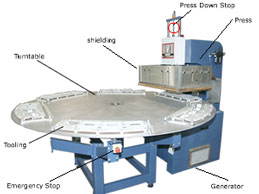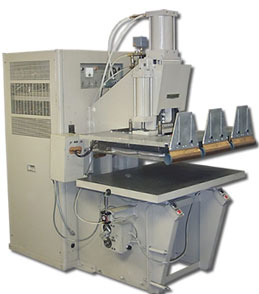RF Heat Sealers
The properties of electromagnetic energy have always lent themselves well to sealing plastics. Just as a microwave oven heats food, an RF heat sealer heats a plastic part to the point at which it can bond with another plastic part or to another surface. The technique is faster and cleaner than conventional thermal welding and also produces a stronger bond. It’s not surprisingly that there are more than 100,000 RF heat sealers in operation in the United States throughout many industries.
As with any system that generates high levels of electromagnetic energy, there are potential safety problems associated with their operation. When designed, operated, and maintained properly, the systems produce extremely low levels of radiation in the vicinity of the operator.
Potential Problems with RF Heat Sealers
If the shields designed to protect the operator from overexposure conditions are not properly deployed, if the shields are in some way defective, or if the design of the heat sealer itself does not pay adequate attention to shielding, the level of radiation to which the heat sealer operator may be exposed can be orders of magnitude higher than what is considered safe. Clearly, the potential for severe overexposure exists.
The power generated by an RF heat sealer ranges from about 1,500 Watts to more than 60,000 Watts—a power level comparable with the highest power radio and television transmitters. While the power radiated by a broadcast antenna is emitted from an antenna located high on a tower, an RF heat sealer delivers its energy inches from the operator.
For years, many RF heat sealers were not well designed in terms of RF safety. That situation has changed, and the vast majority of the heat sealers being sold today address the RF safety issue. However, there are countless older heat sealers still in use.
Even well-designed sealers can cause problems, as with the following examples.
- The shields are mechanical systems that can fail. If the shield does make electrical contact with the work surface, or platen, even a one-inch gap can lead to very high RF exposure for an operator. Exposure to RF fields at heat sealer frequencies can cause current to be induced into the operator. Thes induced currents are most concentrated in the ankles, where the cross-sectional area is smallest. When an operator complains of “hot ankles,” it is a good indication of significant induced currents.
- Bar-style RF sealers are particularly problematic because the shields cannot surround the part being sealed or welded. Bar sealers are often used to join fabrics, such as those used in manufacturing tents and similar products.
- Maintenance personnel can be exposed to strong RF fields when they open the door of the generator while the system is operating.
- It is not uncommon for operators to remove the shields that have just been inspected by a supervisor or health and safety professional in order to increase their production rates. When this is done, the operator is subject to overexposure conditions.
Maintaining Safety with RF Heat Sealers
The basic steps to achieving RF safety with heat sealers are as follows:
- Determine the RF field levels under normal operating conditions. This usually requires measurements.
- Establish a simple safety program that includes procedures for both operators and maintenance personnel. Periodic equipment checks are a good idea.
- Train both operators and maintenance personnel. For example, operators should constantly check to be sure that the shields are functioning properly. Much can be achieved by simple observation.
RF Safety Solutions can help you with your RF heat sealers. Contact us to discuss your application.
How RF Heat Sealers Work
RF heat sealers are relatively large industrial machines that have an RF generator within them. The generator is comprised of three basic components—a power supply, an oscillator, and controls. The power supply converts the line power source into high-voltage direct current. The oscillator circuit converts this power into RF energy, generally at a frequency of 27.12 MHz, although other frequencies are sometimes used. This frequency is one of the Industrial, Scientific, and Medical (ISM) frequencies designated by the Federal Communications Commission (FCC) for unlicensed operation. The controls regulate and monitor the operation of the sealer as it heats the seal area. The RF energy is applied to the work via an applicator, which is generally an air-operated press with interchangeable electrodes that vary in shape with the area to be sealed.
The operator typically places the item to be sealed on the applicator and then begins the sealing process by simultaneously pressing two switches. The dual switches are used to ensure that the operator has both hands free of the press. Once the switches are activated, the press and shields begin to close. Once the press has applied the proper amount of pressure, the RF generator comes on, and the heating cycle, typically a few seconds, begins. The generator is then shut off, the press and shields open, and the sealer is ready to process another part.

